310th Fighter Squadron
| 310th Fighter Squadron | |
|---|---|
|
310th Fighter Squadron Patch | |
| Active |
9 February 1942 – 20 February 1946 10 July 1952 – 25 March 1962 15 December 1969 – present |
| Country | United States |
| Branch | United States Air Force |
| Type | Fighter Training |
| Part of |
Air Education and Training Command 19th Air Force 56th Fighter Wing 56th Operations Group |
| Garrison/HQ | Luke Air Force Base |
| Nickname(s) | Top Hats |
| Decorations |
|
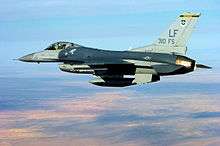
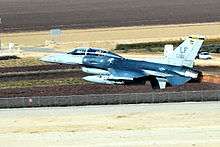


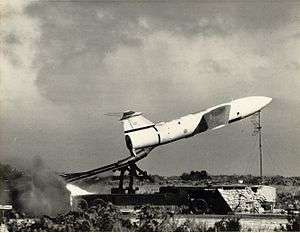
The 310th Fighter Squadron (310 FS) is part of the 56th Operations Group at Luke Air Force Base, Arizona. It operates the F-16 Fighting Falcon aircraft conducting advanced fighter training.
The unit, which adopted its original "Tophat" name in September 1987, has earned two Distinguished Unit Citations, Philippine Presidential Unit Citation, Republic of Korea Presidential Unit Citation, and nine Air Force Outstanding Unit Awards.
Mission
The 310th Fighter Squadron ("Top Hats", Tailband: Green & Yellow), fly Block 42 F-16C and D models conducting training in night operations, forward Air Control-Airborne in the F-16, and "Medium Altitude Navigation and Targeting Infrared for Night" (MANTIRN) training.
History
World War II
The 310th Fighter Squadron was constituted on 21 January 1942, as the 310th Pursuit Squadron (Interceptor) and was activated on 9 February at Harding Field, Louisiana, where it flew the P-39 and P-40 aircraft. During 1942 and early 1943 the squadron was both an Operational and a Replacement Training Unit initially under III Fighter Command, being reassigned to I Fighter Command in October 1942. Also was part of the air defense of the Northeast United States, being a component of several Air Defense fighter wings (Philadelphia, New York, Boston), under First Air Force.
Was converted into an operational squadron in March 1943 at Bradley Field, Connecticut, being re-equipped with P-47 Thunderbolts. Was deployed to the Southwest Pacific Theater, being assigned to Fifth Air Force in Australia in November 1943. Began combat operations in February 1944, providing protection for U.S. bases and escorting transports initially, then escorting bombers over New Guinea and sea convoys to Admiralty Islands. From Noemfoor, bombed and strafed Japanese airfields and installations on Ceram, Halmahera, and the Kai Islands.
Moved to the Philippines in Nov, flew fighter sweeps against enemy airfields, supported U.S. ground forces, and protected sea convoys and transport routes.
Beginning in June 1945, the Mexican squad, Escuadron 201 initially flew missions with the 310th Fighter Squadron, often twice a day, using borrowed U.S. aircraft. It received 25 new P-47D-30-RA aircraft in July, marked with the insignia of both the USAAF and Mexican Air Force. The squadron flew more than 90 combat missions, totaling more than 1,900 hours of flight time. They participated in the Allied effort to bomb Luzon and Formosa to push the Japanese out of those islands.
Beginning in July 1945, attacked railways, airfields, and enemy installations in Korea and Kyushu, Japan from Okinawa. After V-J Day, flew reconnaissance missions over Japan. Moved without personnel or equipment to the Philippines in Dec to be inactivated in January 1946 at Fort William McKinley, Luzon.
Cold War
Reactivated during the Korean War at Taegu Air Base, South Korea, being re-designated the 310th Fighter-Bomber Squadron. First equipped with the Republic F-84G Thunderjet, the squadron adopted the North American F-86 Sabrejet in 1954 and kept it through 1958. During the Korean War, the squadron flew primarily air-to-ground missions supporting ground operations. The 310th FBS participated in the Korea Summer-Fall 1952, Third Korean Winter, and Korean Summer-Fall 1953 campaigns, the squadron again distinguished itself, earning the Republic of Korea Presidential Unit Citation.
After the armistice in 1953, the squadron was moved to Osan Air Base on 19 March 1955. In 1958 the 310th gave up its F-86s when it became the 310th Missile Squadron on 15 June 1958, assigned to the 58th Tactical Missile Group. It remained the home of the surface-to-air MGM-1 Matador missile in South Korea until 1962, when the missile left service, and inactivated on 25 March 1962.[1]
On 1 December 1969, the squadron resurfaced as the 310th Tactical Fighter Training Squadron 1 December 1969: two weeks later, on 15 December 1969 Luke Air Force Base, assuming the personnel and equipment of the provisional 4514th Combat Crew Training Squadron. Initially flying the new A-7 Corsair II ground attack aircraft, aircraft carrying tail code "LA" with blue tail stripes. Began transition to the McDonnell-Douglas F-4C Phantom II in July 1971, assuming training mission from Davis-Monthan AFB units. Operated the F-4C until April 1982. aircraft carrying green fin caps. The squadron started phasing out the F-4 for the Block 1 F-16A Fighting Falcon in 1982, with the distinction of operating the first production F-16 #78-0001. Deactivation with the F-4C was on 4 November 1982. F-16s initially tail coded "LA", recoded to "LF" on 1 January 1983.[1]
In the early years of operation with the F-16, the squadron patch was very different and the squadron name was Falcons. Eventually the 310th would return to the patch style used in World War II with a tophat wearing skull with a pair of dice (see patch top of page). The squadron name changed as well to "Top Hats" which it has carried through to today.[1]
In 1988 the 310th TFTS began receiving brand new block 42 F-16C/Ds to replace the F-16A/B. The 310th TFTS became the first unit to receive the block 42 and also became the first F-16 squadron to receive the LANTIRN night vision system. Instructor pilots assigned to the 310th developed and wrote the Replacement Training Unit syllabus for both the Block 40/42 and LANTIRN. They also developed the first LANTIRN tactics. Until the mid-1990s, the 310th was dedicated almost exclusively to the LANTIRN training mission.[1]
Modern era
On 1 November 1991 the 310th was re-designated simply as a Fighter Squadron. Although the word 'Training' was dropped, nothing in that role was changed and was the case for all USAF Tactical Fighter Training Squadrons at that time.[1]
During the late 1990s with the growing use of night vision goggles the 310th FS has become the principle trainer in this role. It was several years later that the squadron began training night-vision goggle qualified pilots. Although now well known for night vision training, the 310th FS is also tasked with other pilot training normally in the realms of advanced pilot training. One such program is Forward Air Controller, of which the 310th FS is currently the only squadron in the USAF that trains F-16 pilots in this role. Each class lasts five weeks and includes twelve sorties intended to test technical knowledge of the program. The 310th Fighter Squadron on average graduates thirteen classes of FAC qualified pilots a year.[1]
Beginning in April 2004 the 310th FS was tasked with all night vision goggle training. Pilots going through this training program have to be experienced as the night vision goggles prove to be very challenging. New pilots to the training program have known to follow stars in the sky thinking they are following their flight leader. In bad weather the goggles can be useless as they depend on some source of light. A common training element is to have students fly in a four ship formations on a strike mission having to fight their way in and out against enemy aggressors. In all, a trainee will face three to four weeks of training using the goggles including simulator time and eight sorties in the real jet. Although it fluctuates, the school often turns out 150 night vision goggle trained pilots a year.[1]
Lineage
- Constituted as 310th Pursuit Squadron (Interceptor) on 21 Jan 1942
- Activated on 9 Feb 1942
- Re-designated: 310th Fighter Squadron on 15 May 1942
- Re-designated: 310th Fighter Squadron, Single Engine, on 20 Aug 1943
- Inactivated on 20 Feb 1946
- Re-designated 310th Fighter-Bomber Squadron on 25 Jun 1952
- Activated on 10 Jul 1952
- Re-designated: 310th Tactical Missile Squadron on 15 Jul 1958
- Discontinued, and inactivated, on 25 Mar 1962
- Re-constituted and re-designated 310th Tactical Fighter Training Squadron on 11 Dec 1969
- Activated on 15 Dec 1969
- Re-designated as 310th Fighter Squadron on 1 Nov 1991.
Assignments
- 58th Pursuit (later, 58th Fighter) Group, 9 Feb 1942
- Fifth Air Force, 27 Jan – 20 Feb 1946
- 58th Fighter-Bomber Group, 10 Jul 1952
- Attached to 58th Fighter-Bomber Wing, 1 Mar – 7 Nov 1957
- 58th Fighter-Bomber Wing, 8 Nov 1957
- 314th Air Division, 1 Jul 1958
- 58th Tactical Missile Group, 15 Jul 1958 – 25 Mar 1962
- 58th Tactical Fighter Training (later, 58 Tactical Training) Wing, 15 Dec 1969
- 58th Operations Group, 1 Oct 1991
- 56th Operations Group, 1 Apr 1994 – present
Stations
|
|
Aircraft and missiles
|
|
Operations
See also
Emblems
-
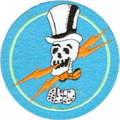
310th Fighter Squadron (World War II)
-
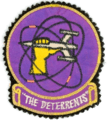
310th Tactical Missile Squadron (1960)
-
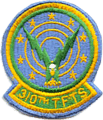
310th Tactical Fighter Training Squadron (1982-1988)
References
![]() This article incorporates public domain material from the Air Force Historical Research Agency website http://www.afhra.af.mil/.
This article incorporates public domain material from the Air Force Historical Research Agency website http://www.afhra.af.mil/.
- USAF 310th Fighter Squadron History
- 56th Operations Group Fact Sheet
- Rogers, Brian. United States Air Force Unit Designations Since 1978. Hinkley, England: Midland Publications, 2005. ISBN 1-85780-197-0.
- Martin, Patrick. Tail Code: The Complete History of USAF Tactical Aircraft Tail Code Markings. Schiffer Military Aviation History, 1994. ISBN 0-88740-513-4.

